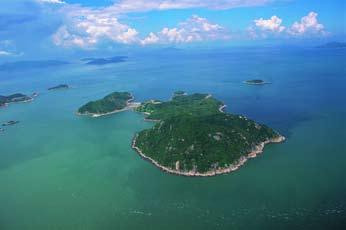
6 minute read
江豚在香港的情況
32
江豚在香港的情況 Their status in HK
Advertisement
發現過江豚。有趣的是,雖然中華白海 豚及江豚的生活範圍在香港某些水域有重 江豚與中華白海豚在 香港水域裡從不碰頭 疊,但研究員從未曾在這些區域見過此兩品 Finless porpoises and Chinese 種同時出現。為何江豚好像永遠要避開中華白 white dolphins appear to 海豚主要出沒的生境呢?此獨特的生境分隔的背後 avoid each other in Hong Kong waters 原因,對香港鯨豚研究員來說仍然是一個謎。一些研究 員認為,江豚及中華白海豚在食物資源上可能存在著一些競爭;有些則估計兩者 之間或出現一些具侵略性的行為,而這些行為可能是身體上的碰撞、或利用聲音 對對方作出一些滋擾;另有說法認為江豚在香港的分佈主要跟牠們繁殖的時間及 由珠江排出的淡水量有關;最後的說法看來較為合理,所以在此再作深入探討…

33
In Hong Kong, finless porpoises can be found year-round and are considered a resident species. Porpoises mainly occur in the southern and eastern waters of Hong Kong, and largely avoid the western waters where Chinese white dolphins are found. In fact, researchers have never seen a single porpoise to the north and west of Lantau. It is interesting to note that the range of finless porpoises does overlap with that of Chinese white dolphins in some areas, but the two species have never been seen interacting with each other. So why do porpoises appear to avoid the prime habitat of the dolphins, and why do they never interact with each other? The driving force of this “habitat partitioning” is still a mystery to local researchers. Some suggest that dolphins and porpoises may be competing with each other over food resources. Others have even speculated that aggressive behaviour (either physical or acoustic) may take place between the two species. Another plausible explanation may be related to the timing of when porpoises reproduce and freshwater outflow volume of the Pearl River. What does that mean?
Porpoises in Hong Kong exhibit distinct seasonal variation in their distribution. They are most abundant 江豚母子大多於冬春兩 during winter and spring months, when they mainly 季在香港南面水域出沒 occur in South Lantau and Lamma waters. Then
Mother and calf pairs of porpoises will mostly disappear from these waters finless porpoises are often in summer and autumn months, while porpoise o b s e r v e d i n s o u t h e r n occurrence tends to increase in eastern waters during waters of Hong Kong during these months. Researchers noticed that porpoises in winter and spring months Hong Kong showed distinct reproductive seasonality with most births estimated to occur between October and January. Observations from land also revealed that more mother-calf pairs can be found closer to shore during the months when they mainly occurred in South Lantau and Lamma. Therefore, porpoises may be moving to inshore waters during their calving season to find sheltered bays with abundant food resources while nursing their young. The timing of the reproductive cycle of porpoises may explain why their density is much higher during winter and spring months in South Lantau and Lamma. To sum it up, reproductive seasonality of porpoises could be the main driving force for their seasonal movement in and out of the southern waters of Hong Kong during certain months of the year. The porpoises may also have such seasonal shifts to take advantage of Chinese white dolphins moving out of these


southern waters when the influence of the Pearl River becomes insignificant there.
34
看過江豚在香港的整體分佈 後,我們再細看牠們會否偏 愛某類生境。經過詳盡的 棲身地運用分析,研究員 發現江豚的密度明顯地在 大鴉洲(索罟群島南面的島 嶼)、石鼓洲、長洲、南丫 島西南角、蒲台島一帶水域 較高。這些水域均有一些類 似的特質,例如均集中在島 嶼附近、有較傾斜的海床坡 度(即水深差別較大)、及遠 離人類活動(如船隻或漁船 經常經過)的地方。雖然研 究員對江豚的生境要求還未 能完全掌握,但可以肯定以 上的水域都是牠們的主要生 境,必須加以保護,以防受 到人為活動及沿岸發展所破 壞﹗ 在香港較常發現江豚蹤影的一些水域
貝澳灣及石鼓洲 Pui O Wan and Shek Kwu Chau



索罟群島 Soko Islands
35
A few porpoise “hotspots” in Hong Kong
南丫島 Lamma Island



蒲台群島之橫瀾島 Waglan Island of Po Toi Islands Besides the general distribution pattern in Hong Kong waters, finless porpoises seem to exhibit some preference for certain areas as their prime habitat or hotspots. For example, from a detailed analysis of porpoise habitat use, it was shown that porpoise densities were particularly high near Tai A Chau (the southern most island of the Soko Islands), Shek Kwu Chau, Cheung Chau, near the southwest corner of Lamma Island, and around the Po Toi Islands. These favourite spots for the porpoises all share similar habitat characteristics: they are usually located around an island, with steep seabed gradients nearby (or great dropoffs in water depth), and areas without much human activities, such as vessel traffic or fishing activities. Although the habitat requirements of porpoises are not fully understood, these hotspots can all be considered important porpoise habitats that should be safeguarded from anthropogenic activities including coastal development!
36
Using the line-transect survey method along with acoustic data collection, the minimum abundance of finless porpoise in Hong Kong has been estimated to vary from 55 porpoises in autumn to 152 porpoises in spring, indicating a good portion of animals are outside of Hong Kong in autumn months. While porpoises appear to undergo some seasonal shifts from southern waters to eastern waters, this may not tell the whole story, as porpoises may also shift from southern waters to offshore waters in Guangdong Province in summer and autumn months. Indeed, surveys in adjacent Chinese waters also showed that more porpoises occurred south of Hong Kong’s territorial boundary in the summer months. 無法分辨個別江豚的身份令 研究工作舉步維艱


The inability to identify individual porpoises makes them a very challenging research subject to understand their occurrence and abundance
37
香港的江豚數目估計已十年未曾更新,但研究員卻無意著力更新這個數字。為甚 麼呢?那是因為更新香港的江豚數目意義不大。經過十多年的江豚研究,研究員 明白他們根本無法掌握個別江豚在香港的出現情況及移動模式。由於無法辨認個 別江豚,所以無人知曉在香港出現的江豚會否日復日、月復月、年復年地出現。 即是說,今天看到的江豚跟明天的江豚是否相同、又或去年看到的江豚是否今年 所看到的,研究員都無法得悉。再者,要找出香港所屬的江豚種群的分佈範 圍,幾乎是不可能達成的任務,因為此種群範圍的邊界線可能遠離香港數 十、甚至數百公里。所以,如果無法知道個別江豚的身份及無法掌握江 豚種群的出沒範圍,在香港的某一地方及某一時間所估計出來的數目統 計,可能並無太大意義。所以,研究員現時主要把資源花在找出江豚 的重要棲身地,以保護這些水域免受人為活動的破壞。

The abundance estimate of finless porpoises in Hong Kong is fairly out-dated because the research was done about ten years ago, but researchers are not keen on updating this estimate. Why? It is mainly because estimating abundance of porpoises may not be a meaningful exercise after all. The main problem is that researchers may never know anything about the residency and individual movement patterns of the finless porpoises they have been studying in Hong Kong for over a decade. And because porpoises cannot be identified individually, no one will ever know whether the same porpoises have been showing up in Hong Kong everyday, every month, or from year to year. Also, it would virtually be a “mission impossible” to determine the range of the population, which may extend tens or even hundreds of kilometers away from Hong Kong waters. So researchers will never have a good handle on how to define the population boundary for Hong Kong’s finless porpoises. Basically, without knowing the identity of individual porpoises, and with virtually no information on their ranging pattern or the boundaries of the population, counting the number of porpoises occurring in a certain area and specified period of time may have limited value. Therefore, the focus of the current research in Hong Kong is more geared towards determining important porpoise habitat areas and to ensure that porpoises can continue to utilize these habitats without degradation.



